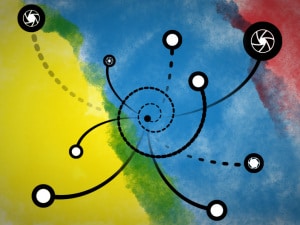
“My vision when we started Google 15 years ago was that eventually we wouldn’t have to have a search query at all. You’d just have information come to you as you needed it.” – Sergey Brin Google
Scene 1: You walk up to a bus stop. You whip out your smartphone. You activate a link and the bus timings of that bus stop show up on your smartphone screen.
Scene 2:You walk into a supermarket, wanting to buy a bottle of tomato ketchup of your favorite brand. You fish out the smartphone from your pocket and activate a link. You are quickly directed on the stock availability of the ketchup you are looking for, including directions to the section of the story where you might find it!
These are not scenes out of a sci-fi movie. These are definitely possibilities just around the bend for commoners like you and me. The Physical Web Project of Google is aiming to do just that and more! With the help of your smartphone and technology embedded in objects around you, your physical world will be at your disposal, similarly as the virtual world is available now. You can find your way out of any situation or solve any practical problem if this project of Google sees the light of day.
What is the Physical Web Project?
Read what Google has to say about the Physical Web Project:
“The Physical Web is an approach to unleash the core superpower of the web: interaction on demand. People should be able to walk up to any smart device – a vending machine, a poster, a toy, a bus stop, a rental car – and not have to download an app first. Everything should be just a tap away.”
The aim of the Physical Web Project can be carried out with the help of two important ingredients:
- Beacons: Deriving the name from the original purpose of beacons, they are points emitting Bluetooth frequencies for a radius of 70 meters or approximately 230 feet. These are called Bluetooth Low Energy. There is no pairing required to access the points. With the help of these Bluetooth beacons, smartphones can detect and access information through frequencies. Apple has brought out this technology from the cold storage where it has been lying dormant for about 2 years now. With Apple using the technology in the form of Beacon, expect others to jump into the arena as well.
- URLs: This is very similar to bar codes that you can find on products at a store. When the billing process is done, the laser gun detects the bar codes and decodes it for the price and other details that are fed automatically into the computer. In the Physical Web Project, URLs will be embedded into objects that can be detected and recognized by smartphone software. The example of finding tomato ketchup in a store given above is a fine example of how URLs can be used by smartphones.
Impact on Searches
When Google is involved in developing a fine-tuning a technology, you don’t expect the search mechanism from remaining unaffected, do you?
The use of the Physical Web Project has tremendous potential in the world of searches, taking us back to the quote at the top of this post. For example, in the world of the Physical Web of Google, when you search for “Nearest dentist from here”, the technology will not require any further information from your end to clarify “here”. It will make use of the Physical Web to find out where you are and what you are looking for and then direct you likewise.
Google is also actively looking into the possibilities of passive searches to enrich this process. With the use of passive searches, Google will conduct searches on your behalf without your participation. It will take into account every little detail, including your location, your preferences by reading your browsing history and accessing your social circles. And when you are really looking for something, you have to key in little or nothing to find what you want! The staggering scale of the project is such that the endless search engine optimization potential is yet to be understood fully!
It all seems like a distant possibility but the Physical Web Project is definitely a step in the right direction.








your web page is really wonderful.. it’s pleasant to read
Thank you for your comment
Nice blog. a new open standards project by Google called ‘Physical Web’ aims to make the experience of navigating the Internet of Things (IoT) in the future much like searching the web today.
Thank you. The Physical Web is an open approach to enable quick and seamless interactions with physical objects and locations.
How does this work?
The Physical Web enables you to see a list of URLs being broadcast by objects in the environment around you. Any object can be embedded with a Bluetooth Low Energy (BLE) beacon, which is a low powered, battery efficient device that broadcasts content over bluetooth. Beacons that support the Eddystone protocol specification can broadcast URLs. Services on your device such as Google Chrome or Nearby Notifications can scan for and display these URLs after passing them through a proxy.
How to do it?
Get beacons. On supported Android devices, you can use Beacon Toy to transform your phone into an Eddystone beacon. Otherwise, choose from a variety of beacon manufacturers.
Configure beacons. You’ll have to select which URLs you’d like to broadcast (browsers such as Chrome and Nearby Notifications only support HTTPS) and how far and often you want your beacons to broadcast.
Deploy. Place your beacons in a physical space. Anyone who passes by with a Physical Web-compatible service will see your URL.